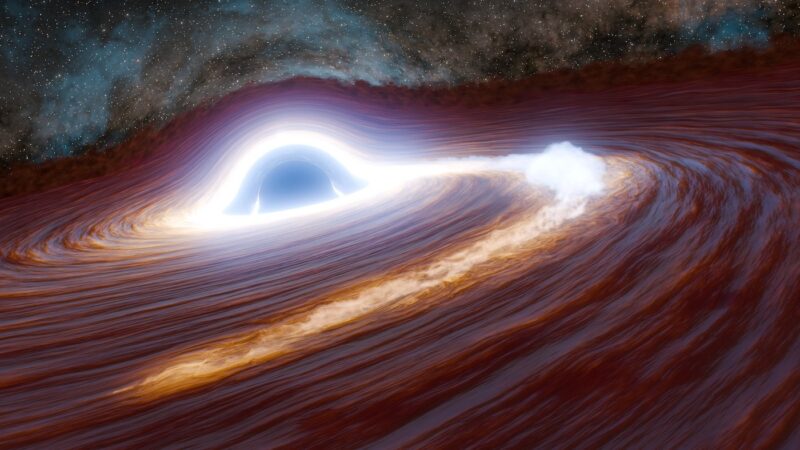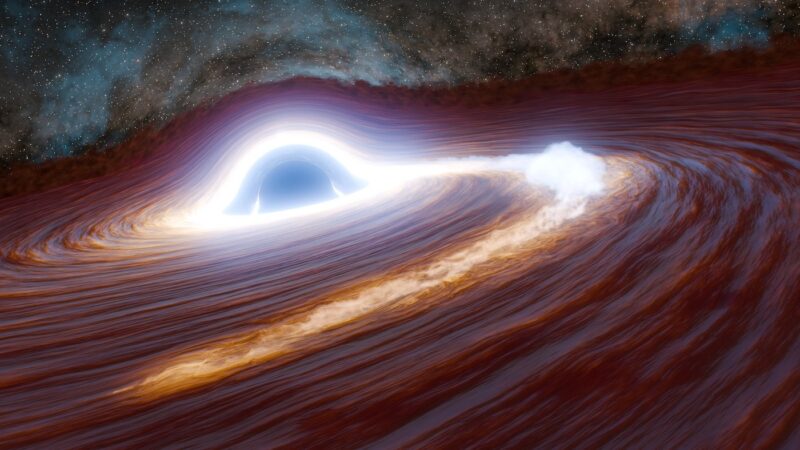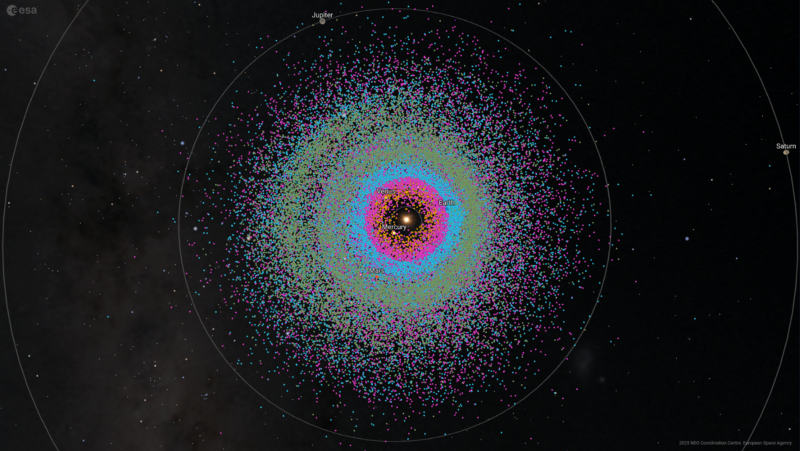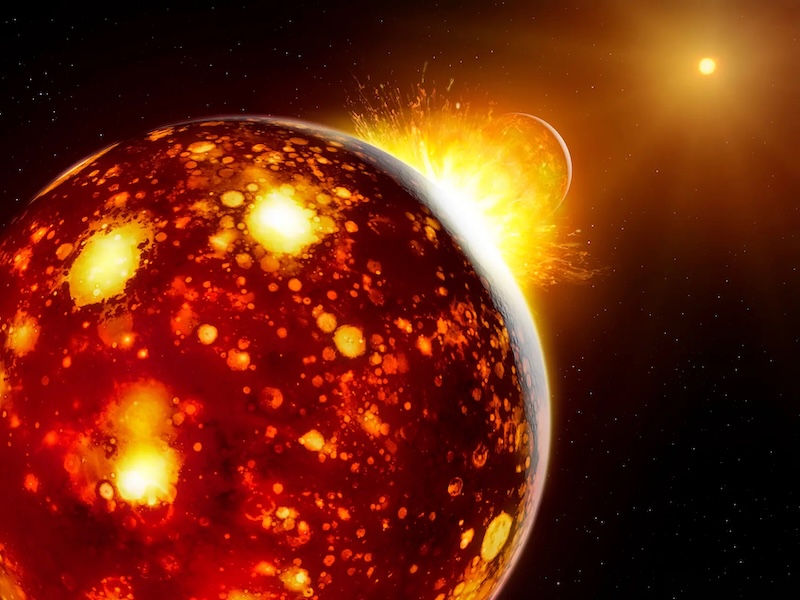Now Reading: Black hole record: Brightest and most distant flare yet
-
01
Black hole record: Brightest and most distant flare yet
Black hole record: Brightest and most distant flare yet


No hype. Just real science, powered by real people.
That’s you. Donate today!
- In 2018, astronomers saw the biggest black hole flare yet. It happened around a black hole 10 billion light-years away.
- The flare was 30 times brighter than any black hole flare we’d seen before. At its brightest, the flare shone with the light of 10 trillion suns.
- It was likely due to a massive star getting too close to the supermassive black hole. The black hole shredded the star, which is slowly spiraling into the black hole.
Caltech published this original story by Whitney Clavin on November 4, 2025. Edits by EarthSky.
The biggest and most distant flare from a black hole
The most massive stars in the universe are destined to explode as brilliant supernovas before collapsing into black holes. Yet one huge star appears never to have fulfilled its destiny; in a twist of irony, the star wandered too close to a gargantuan black hole, which gobbled it up, shredding the star to bits and pieces.
That is the most likely explanation to come from authors of a new Nature Astronomy report on November 4, 2025. It describes the most powerful and most distant flare of energy ever recorded from a supermassive black hole. Scientists first observed the cosmic object in 2018 using the U.S. National Science Foundation (NSF)-funded Zwicky Transient Facility (ZTF), based at Caltech’s Palomar Observatory, and the Caltech-led Catalina Real-Time Transient Survey, which is also funded by NSF. The flare rapidly brightened by a factor of 40 over a period of months. And, at its peak, it shone with the light of 10 trillion suns, making it 30 times more luminous than any previous black hole flare seen to date.
The supermassive black hole behind the flare is a type of accreting, or feeding, black hole called an active galactic nucleus (AGN). Referred to as J2245+3743, this AGN is estimated to be 500 million times more massive than our sun. It resides 10 billion light-years away in the remote universe. Because light has a finite speed and takes time to reach us, astronomers observe distant events like this one in the past, when the universe was young.
Lead author Matthew Graham, research professor of astronomy at Caltech, as well as the project scientist for ZTF and a co-principal investigator of the project, said:
The energetics show this object is very far away and very bright. This is unlike any AGN we’ve ever seen.
Learning more about the black hole flare
Astronomers are continuing to monitor the black hole flare, though it is fading over time. In fact, in addition to witnessing the object in the past, time itself runs slower at the remote site of the black hole compared to our own experience of time. Graham explained:
It’s a phenomenon called cosmological time dilation due to stretching of space and time. As the light travels across expanding space to reach us, its wavelength stretches as does time itself.
Graham also noted that long-lived surveys like ZTF and Catalina are important to fully witness events in the past because, in this case:
… seven years here is two years there. We are watching the event play back at quarter speed.

A star too near a black hole
To determine what could cause such a dramatic burst of light in the cosmos, the researchers thoroughly examined a list of possibilities, concluding that the most likely culprit is a tidal disruption event (TDE). This phenomenon occurs when a supermassive black hole’s gravity shears a star that comes too close. Then it slowly consumes the star over time as it spirals into the black hole. The fact that the black hole flare J2245+3743 is still going on indicates we are witnessing a star not yet fully devoured but rather like. as Graham said:
a fish only halfway down the whale’s gullet.
If the flare is from a TDE, the scientists estimate that the supermassive black hole gobbled a star with a mass at least 30 times greater than that of our sun. The previous record holder for the largest candidate TDE, an event nicknamed Scary Barbie after its initial ZTF classification as ZTF20abrbeie, was not nearly as intense. That TDE, which scientists also think originated from an AGN, was 30 times weaker than that of J2245+3743. And its doomed star is estimated to have been between three and 10 solar masses.
Tidal disruption events
Most of the roughly 100 TDEs seen to date do not take place around active galactic nuclei. Active galactic nuclei are massive structures that consist of supermassive black holes surrounded by large, swirling disks of material that feed the central black hole. The behemoths burble along, flaring up with their own feeding activity, which can mask TDE bursts and make them harder to find. The recent jumbo flare J2245+3743, on the other hand, was so large that it was easier to see.
However, at first, J2245+3743 did not seem to be anything special. In 2018, after researchers spotted the first object, they used the 200-inch Hale Telescope at Caltech’s Palomar Observatory to obtain a spectrum of the object’s light. But it did not reveal anything unusual. In 2023, the team noticed the flare was decaying slower than expected. So they obtained another spectrum from the W.M. Keck Observatory in Hawaii, which indicated the extreme brightness of this particular active galactic nucleus.
A remarkably bright flare
Co-author K.E. Saavik Ford is a professor at the City University of New York (CUNY) Graduate Center and Borough of Manhattan Community College and American Museum of Natural History. Ford said:
At first, it was important to establish that this extreme object was truly this bright.
It was possible, she said, that the object could have been beaming the light toward us rather than glowing in all directions. But data from NASA’s former Wide-field Infrared Survey Explorer (WISE) mission helped rule that out. In the end, after other scenarios were also ruled out, the researchers concluded that J2245+3743 was indeed the brightest black hole flare ever recorded. Ford said:
If you convert our entire sun to energy, using Albert Einstein’s famous formula E = mc2, that’s how much energy has been pouring out from this flare since we began observing it.
A rare star
Once the team established the unprecedented brightness of the event, they looked at what could possibly have caused it. Ford said, as one possibility:
Supernovae are not bright enough to account for this.
Instead, the team’s favored explanation is a supermassive black hole slowly ripping a huge star to death. Ford explained:
Stars this massive are rare, but we think stars within the disk of an active galactic nucleus can grow larger. The matter from the disk is dumped onto stars, causing them to grow in mass.
Finding a black hole meal with such mega proportions indicates that other events like this are likely taking place across the cosmos. The researchers hope to mine through more ZTF data to find others, and the NSF and Department of Energy’s Vera C. Rubin Observatory may likewise find unusually large TDEs. Graham said:
We never would have found this rare event in the first place if it weren’t for ZTF. We’ve been observing the sky with ZTF for seven years now, so when we see anything flare or change, we can see what it has done in the past and how it will evolve.
Bottom line: Astronomers have found a black hole flare that is the biggest and most distant we’ve yet seen. It was likely caused by a massive star getting ripped apart by a supermassive black hole.
Source: An extremely luminous flare recorded from a supermassive black hole
The post Black hole record: Brightest and most distant flare yet first appeared on EarthSky.
Stay Informed With the Latest & Most Important News
Previous Post
Next Post
-
 012024 in Review: Highlights from NASA in Silicon Valley
012024 in Review: Highlights from NASA in Silicon Valley -
 02Panasonic Leica Summilux DG 15mm f/1.7 ASPH review
02Panasonic Leica Summilux DG 15mm f/1.7 ASPH review -
 03How New NASA, India Earth Satellite NISAR Will See Earth
03How New NASA, India Earth Satellite NISAR Will See Earth -
 04And Thus Begins A New Year For Life On Earth
04And Thus Begins A New Year For Life On Earth -
 05Astronomy Activation Ambassadors: A New Era
05Astronomy Activation Ambassadors: A New Era -
06SpaceX launch surge helps set new global launch record in 2024
-
 07Space Force plans new ‘Futures Command’ amid pressure to speed up modernization
07Space Force plans new ‘Futures Command’ amid pressure to speed up modernization



















